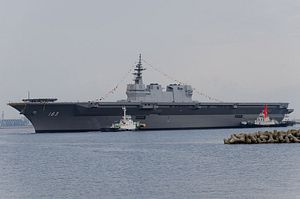The Japan Maritime Self Defense Force (JMSDF) will dispatch its largest warship, the helicopter carrier JS Izumo, on a three-month deployment to the South China Sea beginning in May, according to media reports.
While deployed, the 27,000-ton warship will make port calls in Singapore, Indonesia, the Philippines, and Sri Lanka and is also slated to participate in this year’s trilateral India-U.S.-Japan Malabar naval exercise taking place in the Indian Ocean in July.
According to Japanese defense sources interviewed by Reuters, “the aim is to test the capability of the Izumo by sending it out on an extended mission.” Furthermore, the helicopter carrier “will train with the U.S. Navy in the South China Sea.”
No further details were provided by the Japanese Ministry of Defense.
During last year’s iteration of the Malabar naval drill, which took place in the Philippine Sea in June, the JMSDF sent the Izumo’s predecessor, the 19,000-ton JS Hyuga — the lead ship of the Hyuga-class of helicopter carriers — to participate in the exercise.
The Izumo-class helicopter carrier, officially referred to as a helicopter destroyer in order to downplay the ship’s offensive capabilities, is the largest surface combatant currently in service with the JMSDF. And while the Izumo’s primary role is surveillance and humanitarian assistance and disaster relief missions, the ship can serve as an effective anti-submarine warfare platform.
“The ship is designed to accommodate up to 14 helicopters (seven Mitsubishi-built SH-60k ASW helicopters and seven Agusta Westland MCM-101 mine countermeasure helicopters), five of which can simultaneously take off and land, given the Izumo’s large flight deck and five landing spots,” I explained elsewhere.
While repeatedly denied by Japanese officials and with no official plans to acquire the aircraft in the future, the JMSDF could launch the F-35B is the U.S. Marine Corps variant of the supersonic fifth-generation F-35B Lightning II Joint Strike Fighter, capable of vertical or short takeoffs and vertical landings without requiring a catapult launcher, from the Izumo.
The Japan Air Self Defense Force will procure up to 100 additional new fifth-generation air superiority fighter aircraft by the 2030s and will receive 42 F-35As (the conventional take off and landing variant) over the coming years. However, the Izumo lacks a catapult system necessary to launch conventional fighter jets.
The JMSDF will more likely deploy a number of V-22 tilt-rotor aircraft — a hybrid between a conventional helicopter and turboprop plane with both vertical takeoff and landing (VTOL) and short takeoff and landing (STOL) capability — from the carrier. Japan has placed an order with the United States for a total of 17 V-22s and is expected to receive the first batch of aircraft in 2017.
Next to a OQQ-22 bow-mounted sonar to track enemy submarines, the carrier boasts two Raytheon RIM-116 Rolling Airframe Missile SeaRAM launchers and two Phalanx close-in weapon systems to defend against aerial threats.
The JS Izumo is expected to return to Japan in August. Her sister ship, the Kaga, is scheduled to be commissioned this month.

































